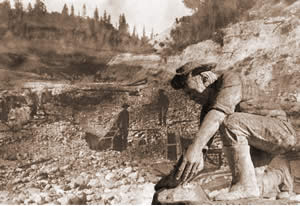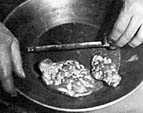Alleghany
Angels Camp
Coloma
Columbia
Dutch Flat
Folsom
Foresthill
Grass Valley
Hammonton
Iowa Hill
Jackson - Plymouth
La Porte
Malakoff
Nevada City
Placerville
Poker Flat
Auburn History
Gold Districts - Introduction
|
INTRODUCTION Between 1848 and 1967, California was the source of more than 106 million troy ounces of gold. This total was far greater than that for any other state in the Union and represented about 35 percent of the total United States production. Although gold was mined in California in the late 18th and early 19th Centuries, the gold rush did not begin until after Marshall's discovery at Sutter's Mill in 1848. Thousands of gold seekers soon arrived, and in a few years much of the state was permanently settled. Gold production attained an all-time high of $81 million in 1852 but then declined because of the exhaustion of the rich surface placers. At the last government-set price of $35 per ounce, the 1852 amount would have been about $138 million.
Although gold is found in many areas in California, the most productive districts are in the northern and central portions of the Sierra Nevada. The primary deposits usually consist of gold-quartz veins in metamorphic rocks and are associated with the intrusion of the Sierra Nevada batholith. In the Klamath Mountains, the second most-productive province, the largest sources of gold have been the streams of the Klamath-Trinity River system. The older terrace deposits along the sides of the present stream channels also have yielded much gold and were mined by hydraulicking. The Basin Ranges and Mojave Desert provinces of eastern and southern California have yielded substantial amounts of gold. The gold occurs either in epithermal deposits in brecciated silicified zones of Tertiary volcanic rocks or in mesothermal quartz veins of older metamorphic and granitic rocks. Gold also has been recovered from dry placers in several districts. Moderate amounts of gold have been mined in the Transverse and Peninsular Ranges in southern California. The mineral also has been recovered from the Modoc Plateau province in northeastern California. Small amounts of gold have been produced in a number of places in the Coast Ranges. THE MINES TODAY California's gold-mining history is a brilliant lure, and many books, pamphlets, periodicals and articles have been published on the subject. The old mining districts and settlements, including "ghost" towns, are visited by increasing numbers of tourists each year. In a few districts the old camps have been reconstructed. Several old gold mining towns, such as Columbia, Johnsville, Coloma, Shasta, and Bodie, are California state parks or recreation areas. In recent years more people have become aware of the importance of California's gold rush in the history and development of the western United States, and steps have been made to preserve historical structures and equipment closely associated with gold mining. Unfortunately, little visible evidence remains of many of California's important gold-quartz mines other than caved shafts and tunnels and heavily overgrown dumps. The surface plants of the large underground lode mines at Grass Valley and along the Mother Lode belt, which for years accounted for a major part of California's gold output, have been almost completely dismantled. More evidence remains of the large-scale placer-mining operations. The old hydraulic mine pits and the extensive tailing piles in the dredging fields still exist; some are used as commercial sources of sand and gravel. A number of the old ditches, flumes, and reservoirs that once supplied water to the hydraulic mines now are parts of hydroelectric and irrigation systems. Edited from: Gold Districts of California, by: W.B. Clark, California Department of Conservation, Division of Mines and Geology, Bulletin 193, 1970. |



 Hydraulic mines become the largest sources of gold until curtailed
by court order in 1884. Lode mines and dredges were the principal
sources after that date. During the depression years of the 1930s,
gold output in the state was nearly as high as it had been during
the gold rush. Gold mining was curtailed during World War II and
has not recovered since. A number of spectacular nuggets
and masses of pure gold were recovered in California during the
early days. The most famous were the 195-pound mass of gold from
Carson Hill and the 54-pound Willard nugget from Magalia. Small
high-grade ore shoots or pockets have been found in many districts,
but the richest and most numerous have been in the Allegany district
of Sierra County.
Hydraulic mines become the largest sources of gold until curtailed
by court order in 1884. Lode mines and dredges were the principal
sources after that date. During the depression years of the 1930s,
gold output in the state was nearly as high as it had been during
the gold rush. Gold mining was curtailed during World War II and
has not recovered since. A number of spectacular nuggets
and masses of pure gold were recovered in California during the
early days. The most famous were the 195-pound mass of gold from
Carson Hill and the 54-pound Willard nugget from Magalia. Small
high-grade ore shoots or pockets have been found in many districts,
but the richest and most numerous have been in the Allegany district
of Sierra County.